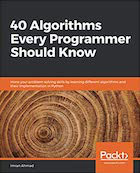By Alvin Alexander. Last updated: August 18, 2024
| Algorithms! | |

|
40 Algorithms Every Programmer Should Know |
As a little note today, here’s an example ZIO 2 application where I do the following:
- Pass a value to the ZIO application (named
app) fromrunusing aZLayer - Use that
ZLayervalue in the application - Pass a result value from the application back to the
runvalue - Use that value in
run - Handle any possible errors in
runwithfoldZIO - Show other ways to write the
runvalue/function
ZIO/ZLayer example
Given that introduction, here’s the ZIO source code:
import zio.*
case class EmailConfig(address: String)
def emailLive(address: String): ULayer[EmailConfig] =
ZLayer.succeed(EmailConfig(address))
/**
* A test where I (a) provide a value to `app` using ZLayer and also
* (b) get a value back from `app` and use that value inside `run`,
* while also (c) accounting for possible errors.
*/
object ZioPassValueBackToRun extends ZIOAppDefault:
val app: ZIO[EmailConfig, Throwable, Int] = for
emailConfig <- ZIO.service[EmailConfig]
_ <- Console.printLine(s"EMAIL: ${emailConfig.address}")
yield
42 // pass this value back to `run`
// [1]
val run: ZIO[Any, Throwable, Unit] =
app.provide(emailLive("coyote@acme.com"))
.foldZIO(
failure => Console.printLineError(s"FAILURE = $failure"),
success => Console.printLine( s"SUCCESS = $success")
)
// [2]
// val run: ZIO[Any, Throwable, Unit] =
// app.provide(emailLive("coyote@acme.com")).tap { result =>
// Console.printLine(s"RESULT: $result")
// }.unit // OR .exitCode here
// [3]
// val run: ZIO[Any, Throwable, Unit] =
// app.provide(emailLive("coyote@acme.com")).mapError { err =>
// Exception(s"ERROR: $err")
// }.flatMap { result =>
// Console.printLine(s"SUCCESS = $result")
// }
Note that I use option 1 to handle run in this code, and I also show two other ways the run value could be implemented, especially when (a) you want to get a value back from the application, and (b) also account for possible errors in the application.
Note that I also show all the ZIO type signatures in the application, so you can follow along more easily here.
As a little summary, if you needed a ZIO 2 example that does these things, I hope this is helpful.
| this post is sponsored by my books: | |||

#1 New Release |

FP Best Seller |

Learn Scala 3 |

Learn FP Fast |